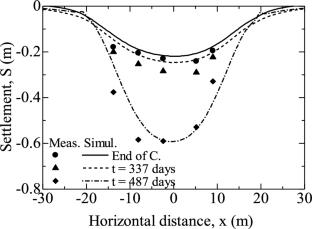Progressive yielding/softening of soil–cement columns under embankment loading: a case study
Abstract
An embankment with a fill thickness of 7.5 m was built on a soil–cement column-slab system improved about 15.8 m thick soft subsoil. The embankment was stable for about 5 months after construction, and then, its settlement rate increased rapidly. To avoid the failure of the embankment, 1.0 m thick fill was removed and the embankment was stabilized again. The results of field investigation using all-core boring through a cement deep mixing (CDM) column under the central of the embankment and 3D finite element analysis (FEA) indicate that the most likely mechanism for the observed field behavior is progressive yielding/softening of the upper part of the columns. In FEA, the yielding/softening of the upper part of columns was simulated using strength reduction option and the start of the softening was triggered manually at the time of observed rapid increase in the settlement rate. This case history indicates that in field quality control of CDM columns, identifying local weak part(s) by continuous measuring the strength of the column samples retrieved from all-core boring is important. It is suggested that combination of unconfined compression test as well as needle penetration tests for the cores retrieved can be an economic and practical way to do this.



 求助内容:
求助内容: 应助结果提醒方式:
应助结果提醒方式:


